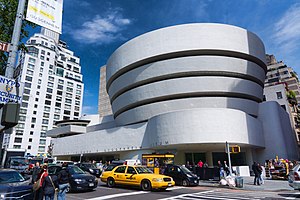
Back Modernisme Afrikaans Klassische Moderne ALS حركة حداثية Arabic تاعصرييت ARY আধুনিকতাবাদ Assamese Modernizm Azerbaijani مودرنیزم AZB Мадэрнізм Byelorussian Мадэрнізм BE-X-OLD Модернизъм Bulgarian
This article contains wording that promotes the subject in a subjective manner without imparting real information. (April 2024) |
This article's tone or style may not reflect the encyclopedic tone used on Wikipedia. (April 2024) |
[additional citation(s) needed]


Modernism is a movement in philosophy, art, and social organization that emerged in response to significant changes in Western society during the late 19th and early 20th centuries. It developed along with widespread industrialization, urbanization, and technological innovation, as well as the cultural shifts brought about by war. Modernism represented a break from traditional forms of art, philosophy, and social organization, seeking instead to express the realities and experiences of the modern world.
Characterized by Ezra Pound's 1934 directive to "Make it New," modernism aimed to challenge and revitalize cultural expressions. Innovations associated with modernism include abstract art, stream of consciousness in literature, montage techniques in cinema, atonal and twelve-tone music, divisionist painting, and modern architecture. The movement was marked by a rejection of realism, an embrace of reprise, incorporation, rewriting, recapitulation, revision, parody[a][b][2], and a critical stance toward Enlightenment rationalism. Many modernists also moved away from religious beliefs.[c][3][4]
A key feature of modernism is its self-awareness and reflexivity about artistic and social conventions, which often led to experimentation with form and techniques that highlighted the making and materiality of art.[5]
Debate continues among scholars about the timeline of modernism. Some argue that it extends into the 21st century, evolving into forms such as late modernism or high modernism.[6] Conversely, postmodernism, which emerged later, is seen as rejecting many of the foundational principles of modernism.[7][8][9]
- ^ "Modernist architecture: 30 stunning examples". Trendir. 2 September 2016.
- ^ Cite error: The named reference
Childs2000p17was invoked but never defined (see the help page). - ^ Cite error: The named reference
Graff73was invoked but never defined (see the help page). - ^ Cite error: The named reference
Graff75was invoked but never defined (see the help page). - ^ Gardner, Helen; de la Croix, Horst; Tansey, Richard G.; Kirkpatrick, Diane (1991). Gardner's Art through the Ages. San Diego, CA: Harcourt Brace Jovanovich. p. 953. ISBN 0-15-503770-6.
- ^ Morris Dickstein, "An Outsider to His Own Life", Books, The New York Times, August 3, 1997; Anthony Mellors, Late modernist poetics: From Pound to Prynne.
- ^ "Postmodernism: definition of postmodernism". Oxford dictionary (American English) (US). Archived from the original on 4 May 2016. Retrieved 16 February 2018 – via oxforddictionaries.com.
- ^ Ruth Reichl, Cook's November 1989; American Heritage Dictionary's definition of "postmodern"
- ^ Mura, Andrea (2012). "The Symbolic Function of Transmodernity". Language and Psychoanalysis. 1 (1): 68–87. doi:10.7565/landp.2012.0005.
Cite error: There are <ref group=lower-alpha> tags or {{efn}} templates on this page, but the references will not show without a {{reflist|group=lower-alpha}} template or {{notelist}} template (see the help page).
© MMXXIII Rich X Search. We shall prevail. All rights reserved. Rich X Search